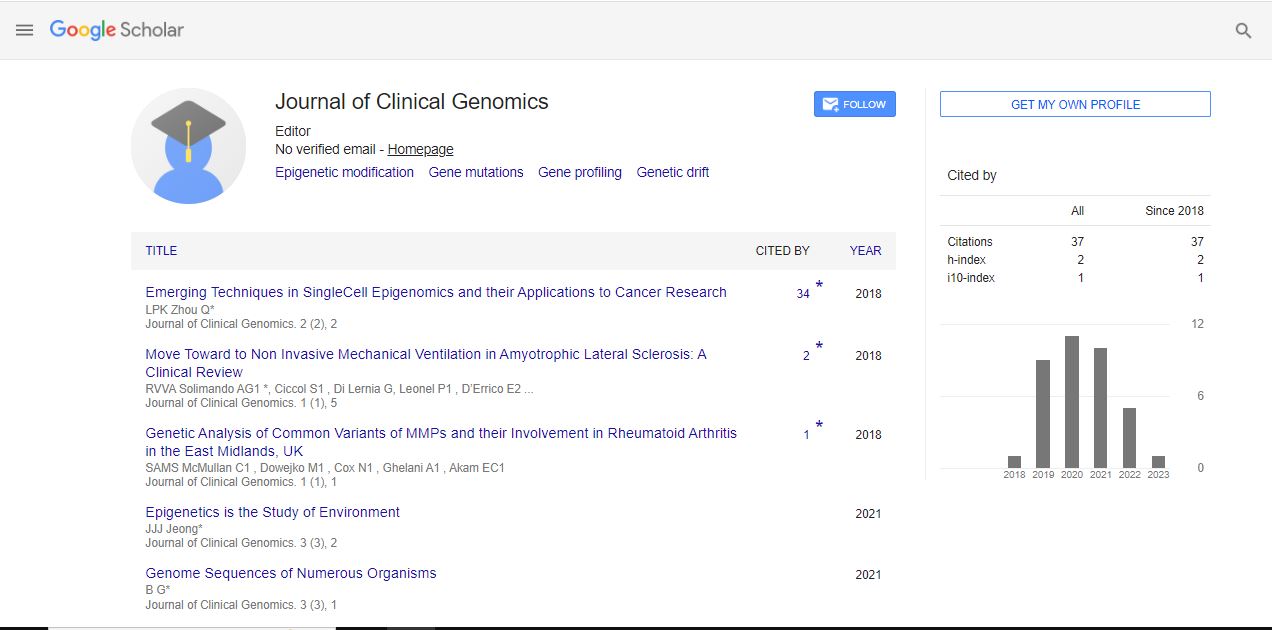Opinion Article, J Chromatography Res Vol: 6 Issue: 4
Enantiomer Elucidation: Chiral Chromatography Innovations in Analytical Chemistry
Renz Baio*
1Department of Chemical and Biological Engineering, Zhejiang University, Hangzhou, China
*Corresponding Author: Renz Baio,
Department of Chemical and
Biological Engineering, Zhejiang University, Hangzhou, China
E-mail: Renbaio93658@zhju.edu.cn
Received date: 27 November, 2023, Manuscript No. JCGR-24-123802;
Editor assigned date: 29 November, 2023, Pre QC No. JCGR-24-123802 (PQ);
Reviewed date: 14 December, 2023, QC No. JCGR-24-123802;
Revised date: 21 December, 2023, Manuscript No. JCGR-24-123802 (R);
Published date: 28 December, 2023, DOI: 10.36648/JCGR.1000078.
Citation: Baio R (2023) Enantiomer Elucidation: Chiral Chromatography Innovations in Analytical Chemistry. J Chromatography Res 6:4.
Description
Chromatography, a versatile and powerful analytical technique, plays a pivotal role in the separation and analysis of enantiomers— molecules that are mirror images of each other but nonsuperimposable. Enantiomeric separations are of immense significance in various fields, including pharmaceuticals, agrochemicals, and food chemistry, as the biological activity of chiral molecules often depends on the specific arrangement of their stereocenters. This essay provides an in-depth exploration of enantiomeric separations using chromatography, covering principles, techniques, applications, and recent advancements.
Principles of enantiomeric separation
Enantiomers possess identical physical and chemical properties except for their interaction with plane-polarized light (optical activity). Chromatographic separation of enantiomers is based on the differential interaction of these mirror-image molecules with a chiral environment. Chirality in chromatography can be introduced through the use of Chiral Stationary Phases (CSPs) or chiral mobile phases. CSPs are stationary phases in chromatographic columns that contain chiral selectors, often derived from natural products or synthetically designed chiral molecules. These selectors selectively interact with one enantiomer over the other, leading to their separation during chromatographic elution.
Cellulose and amylose-based CSPs are widely used for enantiomeric separations. These polysaccharides provide a chiral environment due to their inherent chirality. Chiral proteins, such as Bovine Serum Albumin (BSA) or Human Serum Albumin (HSA), can serve as chiral selectors in CSPs.
Chemically synthesized chiral selectors, such as chiral crown ethers or cyclodextrins, offer versatility and tunability for specific enantiomeric separations. Chirality can also be introduced through the mobile phase in chromatography. This approach involves using chiral additives or chiral solvents to interact differentially with enantiomers during their migration through the chromatographic system. Small chiral molecules, like chiral amines or chiral salts, can be added to the mobile phase to induce enantiomeric separation.
Using chiral solvents, such as chiral alcohols or chiral esters, in the mobile phase can influence enantiomeric resolution. In chiral High- Performance Liquid Chromatography (HPLC), enantiomeric separation occurs on a chiral stationary phase packed into a column. The mobile phase, containing the analyte mixture, interacts with the chiral selector on the stationary phase, resulting in differential retention times and, consequently, separation of enantiomers. Chiral columns in HPLC are available in various chemistries, such as cellulose, amylose, or protein-based columns. The choice of column depends on the specific requirements of the separation.
Detection of enantiomers in chiral HPLC often employs detectors like Ultraviolet (UV), fluorescence, or mass spectrometry, depending on the nature of the analytes. Chiral GC relies on a chiral stationary phase coated onto the interior of the Gas Chromatography (GC) column or incorporated into the polymer coating of capillary columns. Enantiomers interact differentially with the stationary phase, leading to their separation based on retention times. Chiral GC columns include cyclodextrin-based columns, modified polysiloxane phases, and others. The choice of column depends on factors like the nature of the analytes and the required separation efficiency.Common detectors in chiral GC include Flame Ionization Detector (FID), Electron Capture Detector (ECD), and mass spectrometry.
Supercritical Fluid Chromatography (SFC)employs supercritical fluids, typically carbon dioxide modified with a co-solvent, as the mobile phase. Chiral stationary phases, similar to those used in HPLC, are employed for enantiomeric separations. SFC combines the efficiency of liquid chromatography with the speed of gas chromatography, making it suitable for enantiomeric separations of a wide range of compounds. SFC can be coupled with various detectors, including UV, Evaporative Light-Scattering Detector (ELSD), or mass spectrometry. Enantiomeric purity is critical in drug development to ensure the safety and efficacy of pharmaceutical products. Chiral chromatography is used to separate and quantify individual enantiomers in drug substances and formulations. Regulatory agencies often require the submission of data on the enantiomeric purity of chiral drugs.
Chiral pesticides, herbicides, and fungicides may exhibit different biological activities for each enantiomer. Enantiomeric separation ensures accurate quantification and assessment of the environmental impact of agrochemicals. Chiral compounds in flavors and fragrances contribute to their unique sensory characteristics. Enantiomeric separations help characterize and control the quality of chiral aroma compounds. Chiral compounds in food, such as amino acids, may have different nutritional properties based on their enantiomeric form.
Chiral chromatography is employed for the determination of enantiomeric composition in food products. Multidimensional chromatography involves the coupling of two or more chromatographic techniques, enhancing separation power. This approach has been applied to enantiomeric separations, providing higher resolution and improved peak capacity. Chiral ionic liquids have emerged as promising chiral selectors in chromatography. Their unique properties offer a new avenue for enantiomeric separations, particularly in unconventional or challenging matrices. Advances in automation and high-throughput screening have accelerated enantiomeric separations. Automated systems coupled with chiral chromatography enable rapid analysis of large sample sets. Computational methods, including machine learning algorithms, assist in predicting optimal chromatographic conditions for enantiomeric separations.
 Spanish
Spanish  Chinese
Chinese  Russian
Russian  German
German  French
French  Japanese
Japanese  Portuguese
Portuguese  Hindi
Hindi 